Intel Core i7 4960X (Ivy Bridge E) Review
by Anand Lal Shimpi on September 3, 2013 4:10 AM EST- Posted in
- CPUs
- Intel
- Ivy Bridge
- Ivy Bridge-E
Video Transcoding
With our lightly threaded tests behind us, it's time to move to more CPU intensive pastures.
We migrated to the latest verison of the x264 HD benchmark which features a much newer version of x264 and a much heavier workload. The focus here is on quality rather than speed, thus the benchmark uses a 2-pass encode and reports the average frame rate in each pass.
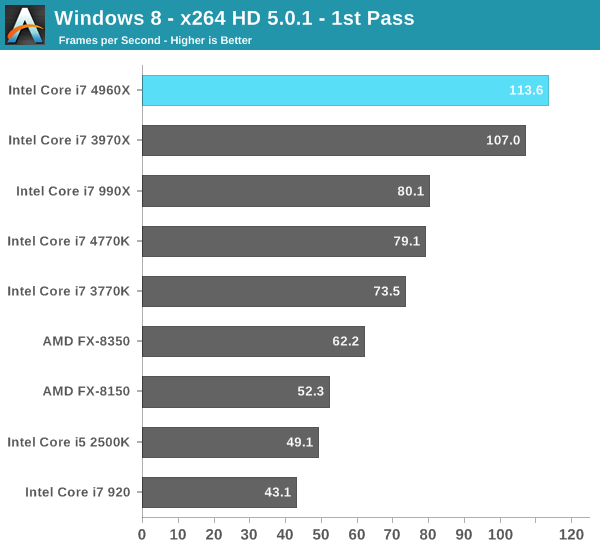

Here we see all of the 6-core parts rise to the top, including Intel's old Gulftown based Core i7-990X. Despite being a few years old at this point, the 990X's 6-core design and relatively high clock speed gives it better performance here than the quad-core Haswell 4770K.
The 4960X manages to be around 30% faster than the old 990X, and is 40% faster than the 4770K. For heavily threaded applications, there's simply no replacement for more cores.
Just like I did earlier, I dusted off one of our really old x264 tests so we'd have comparison data to even older CPUs including the Pentium 4 and Penryn based Extreme Edition parts:
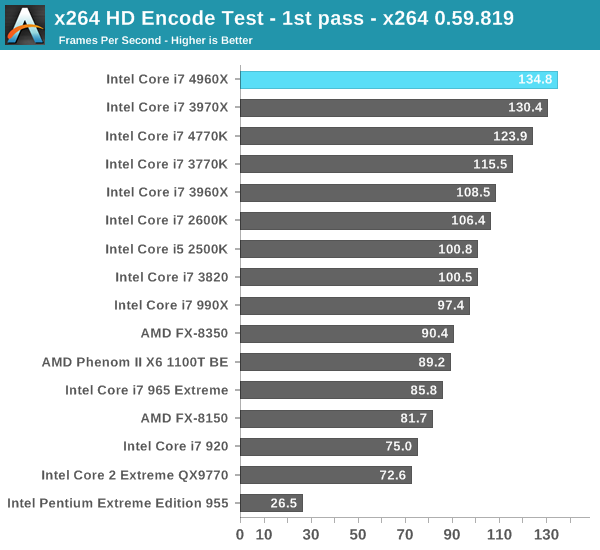
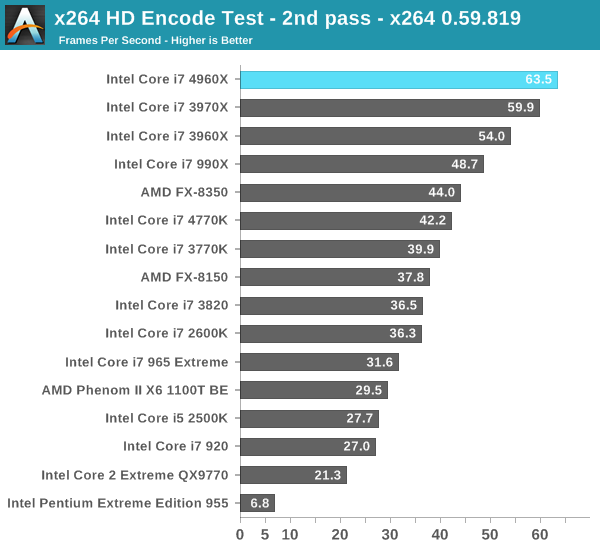
The 4960X manages to deliver nearly 3x the performance of Intel's flagship from 6 years ago. The Pentium EE 955 comparison is even more insane. IVB-E is basically an order of magnitude faster than the last high-end Pentium 4s to come out of Intel back in 2005.
3D Rendering
Our new POV-Ray benchmark uses the latest beta binary (3.7RC6) and runs through both single and multithreaded versions of the popular raytracing benchmark.
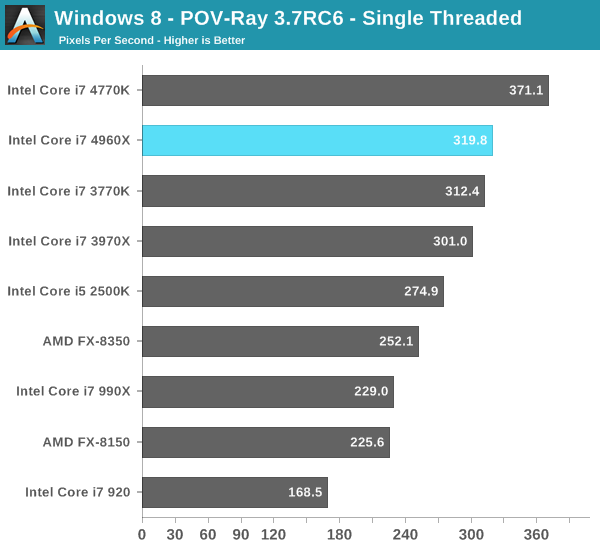
Isolating a single core shows us exactly what we're missing by having Ivy Bridge at the heart of the 4960X instead of Haswell. Here the 4770K manages a 16% performance advantage over the 4960X, which costs 3x as much and draws substantially more power. Looking at AMD's FX-8350 however it's clear why Intel can get away with launching a high-end 6-core chip without its latest cores. Piledriver's single threaded performance falls somewhere between Nehalem and Sandy Bridge, giving Intel room to launch another Ivy Bridge based high-end SKU in 2013 and get away with it.
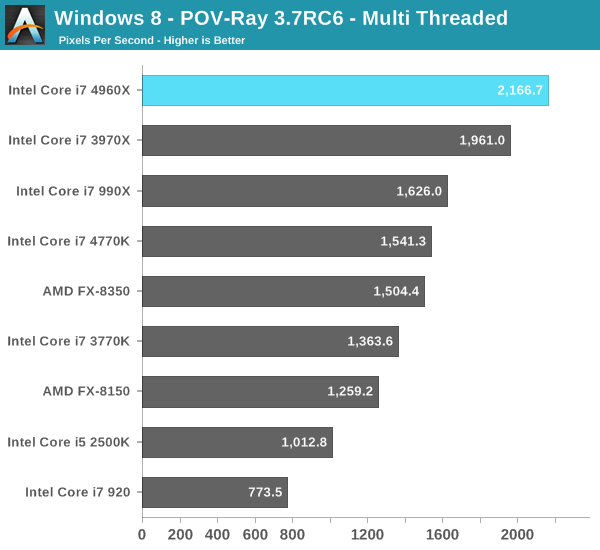
The multithreaded performance story is very different. Here even the Gulftown based 990X is faster than Haswell thanks to its six cores. The 4960X is 40% faster than the Haswell based 4770K. Even AMD's FX-8350 does really well here, basically equalling Haswell's performance.
Created by the Cinema 4D folks we have Cinebench, a popular 3D rendering benchmark that gives us both single and multi-threaded 3D rendering results.
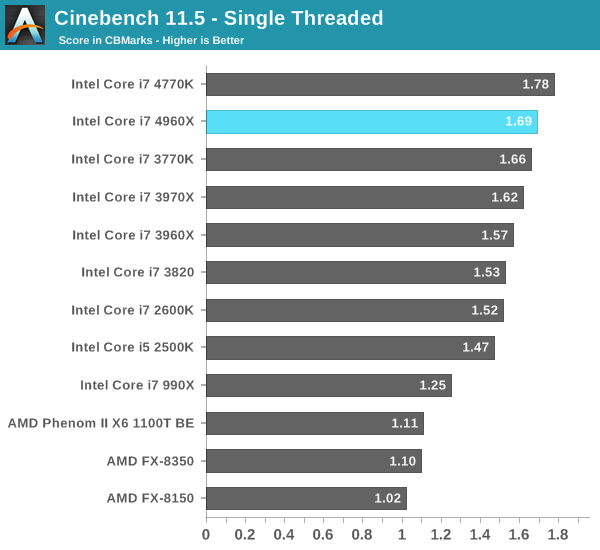
In Cinebench, the single threaded Haswell/IVB-E gap narrows to 5%.
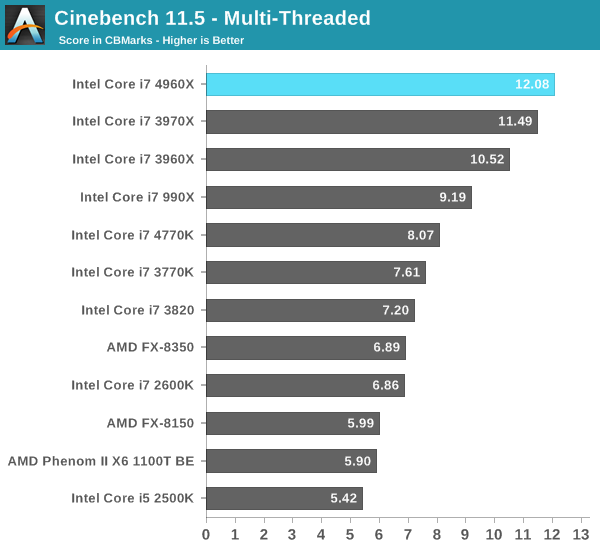
Multithreaded performance continues to be just stellar. Here the 4960X is just under 50% faster than the 4770K. Note the relatively small gap between the 4960X and the SNB-E based 3970X however - the performance gain is only 5%. The bulk of Ivy Bridge's advancements were in GPU performance (not applicable to IVB-E) and power consumption (which we'll get to shortly).
Our final two Cinebench tests use the R10 benchmark to enable a comparison to more/older data points:
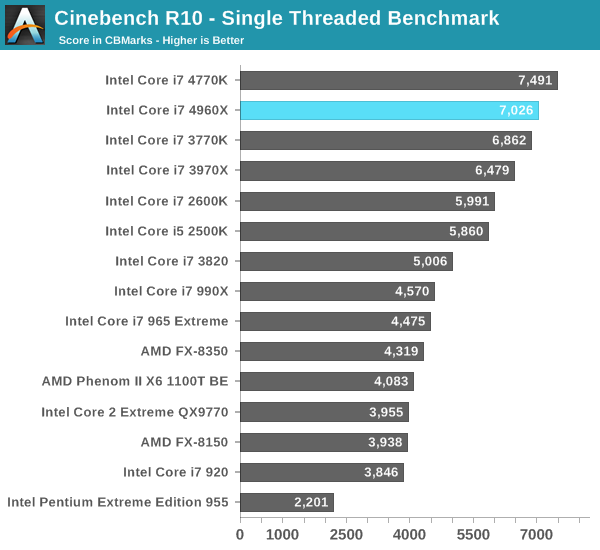
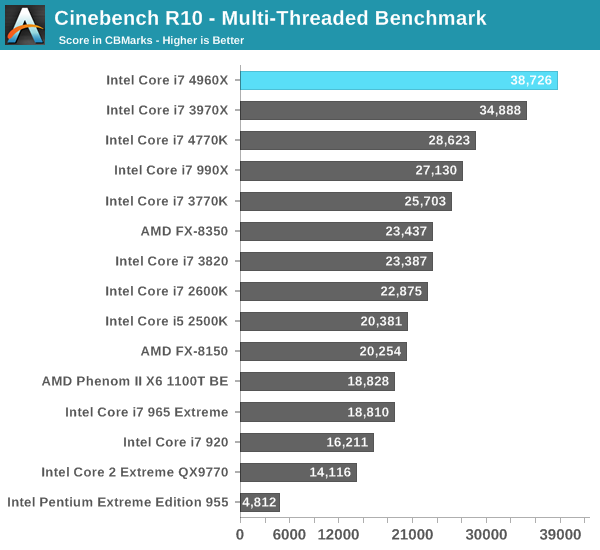










120 Comments
View All Comments
knirfie - Tuesday, September 3, 2013 - link
Why not use a gaming benchmark that does benefit from the extra cores, such as Civ5?ShieTar - Tuesday, September 3, 2013 - link
Or Starcraft 2?JarredWalton - Tuesday, September 3, 2013 - link
Hahahaha.... best 1.5 core benchmark around!althaz - Tuesday, September 3, 2013 - link
It sure does murder one core though.BrightCandle - Tuesday, September 3, 2013 - link
or Arma 3.There are games out there that can utilise more cores and yet you didn't test with any of them.
bds71 - Tuesday, September 3, 2013 - link
as someone who regularly does encoding, 4k gaming, and (when not in use otherwise) folding@home - all things which can fully leverage mult-core processors and powerfull GPUs - i look forward to these reviews of new enthusiast class processors. and, it saddens me that since SB-E there have been only marginal improvements in this sector. i never thought we (as a technology power-house, and as a society) would settle for this. for me, it all began when they started putting GPUs on-die with CPUs for desktop PCs (sure, for laptops i can certainly understand) - i mean who DOESN'T use a discreet GPU in a desktop system???? and for those who do, why don't you just get a laptop???GPUs on-die took the focus away from the CPU. and, while there are minimal gains to be had, the showing here today is abysmal. 2 yrs of waiting and we get a 5% increase (for what i do, i want power and could really care less about power draw - as i would say most enthusiasts do). i get it - to build more powerful hardware, it HAS to become more efficient, but it's an evolutionary development process. haswell could very easily be an enthusiast class product: get rid of the rediculous GPU (for the desktop), double the core count, and raise the TDP to 125/130 (haswell-E?) - and they could do it a LOT earlier than 1-2 years from now. come on Intel - stop screwing the guys who you built your reputation on (after all, it's always the fastest/most powerfull hardware that's shown in reviews to boost the reputation of any company).
/rant off/ sorry, this is just very dissapointing.
f0d - Tuesday, September 3, 2013 - link
i agree very disappointingtoo much integration and not enough performance is the problem with modern intel cpus
i dont want integrated graphics and vrm's and whatever else they plan on integrating - i want huge core counts in a single die for the enthusiast platform.!
jabber - Tuesday, September 3, 2013 - link
I think what folks forget is -Just how many of these chips does Intel actually sell a year?
I bet it's tiny. I bet the i3/i5 chips outsell them 50 to 1. Thats why stuff isn't happening at the top so much. The demand has dwindled. Ten years ago a lot of people could eat all the cpu power they could get their hands on. Now? Not so much. Plenty people now still happy with their 2008/9 spec quads. Basically these top end Intel i7 chips are the Mercedes S class. A way for Intel to put new stuff and techniques in, that may or may not filter down in the future generations.
Intel knows the figures and it knows that the action is at the other end of the spectrum. Not for folks that largely want to rip video and run benchmarks all day.
f0d - Tuesday, September 3, 2013 - link
i agree they dont sell as many as the lower end cpu's but why not just sell us an unlocked xeon than can also OC?its not like they would lose money from letting us OC the xeon because the people that would normally buy a xeon for servers etc would never think about overclocking them
then its a win/win situation for intel as they are still getting their xeon money and they will have a decent enthusiast cpu also
and yes i would happily pay 1k (the price i can find current SBE 8 core cpu's) for an OCable 8 core
jabber - Tuesday, September 3, 2013 - link
Indeed and in being happy to pay $1000 for a CPU that puts you in a very very small group.Times are tough. Sell low and sell many.